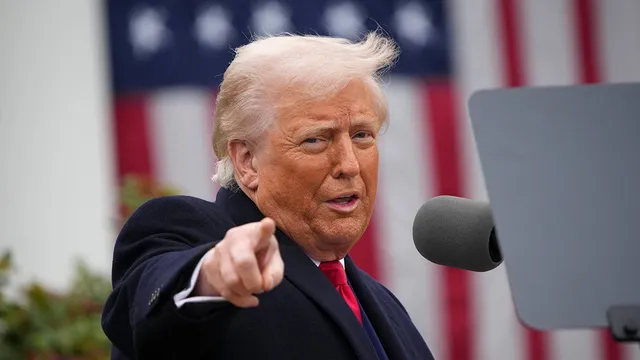
Supreme Court blocks reinstatement of 16,000 federal workers fired by Trump
2025-04-09 16:58- The Supreme Court blocked a ruling that required the reinstatement of 16,000 federal workers fired by the Trump administration, reflecting ongoing legal conflicts.
- Dissenting justices highlighted concerns over standing and the Executive Branch's authority in personnel decisions.
- This ruling signals a complex legal battle ahead for federal employment rights and the administration's workforce reduction initiatives.
Express your sentiment!
Insights
In 2023, the Supreme Court made a significant decision regarding federal employment in the United States by temporarily halting a California judge's ruling that mandated the reinstatement of approximately 16,000 federal workers. These workers had been slated for termination by the Trump administration as part of an initiative to reduce the federal workforce under the auspices of the Department of Government Efficiency led by Elon Musk. This ruling emerged in the context of a complex legal battle involving claims from several nonprofit groups that contested the firings, arguing that they were executed without proper justification and due process. The Supreme Court’s unsigned order indicates that Justices Sonia Sotomayor and Ketanji Brown Jackson dissented, reflecting a divided stance within the Court itself. The Court acknowledged that the claims made by the nonprofit organizations in support of the affected workers might lack sufficient standing under established law. At the same time, the government’s appeal argued that the lower court’s decision violated the separation of powers by encroaching upon the Executive Branch’s authority over personnel management and was characterized by a hasty decision-making process. The situation was further complicated by a concurrent ruling from a Maryland judge requiring certain affected employees to remain on paid administrative leave during ongoing litigation, illustrating the contradictory legal landscape surrounding the employment status of these federal workers. Legal interpretations about standing and the grounds of the firings led to this contentious judicial action. The Supreme Court stressed that the decision at hand was primarily focused on the standing of the nonprofit groups rather than the individual claims of the employees directly involved, underscoring the technical nature of legal arguments concerning jurisdiction and authority in employment matters. Meanwhile, labor unions opposing the administration’s moves maintained that the firings were part of a broader attack on workers' rights and public services, highlighting the pressing need for judicial scrutiny of governmental employment practices. In this turbulent climate, both sides of the legal spectrum are gearing up for a prolonged battle that will likely shape the future of federal employment and governance. The case showcases the larger implications of the ongoing ideological divisions in American politics, particularly around issues of labor rights, government efficiency, and judicial power. The Trump administration's push towards limiting the size of government and its impact on public servants has been met with fierce opposition from labor advocates and oppositional parties, calling into question the balance of power and accountability in federal employment actions as they unfold. The conflicting rulings illustrate a critical moment in American judicial and political arenas, with the potential for significant ramifications for thousands of federal workers caught in the crossfire.
Contexts
The impact of Supreme Court decisions on federal employment has been significant and multifaceted, affecting various aspects of employment law and workplace rights. Through landmark rulings, the Supreme Court has defined the legal landscape for federal employees, particularly in relation to discrimination, employee rights, and the balance of power between federal agencies and employees. These decisions have not only shaped the policies of federal employment but have also influenced the behavior of employers and the expectations of employees within the federal sector. As a result, federal employment practices have evolved in response to the enforcement of constitutional principles and statutory protections highlighted by the Court's opinions. One of the most critical areas of impact has been the Court's interpretation of anti-discrimination laws. Decisions clarifying the scope of Title VII of the Civil Rights Act of 1964 have played a crucial role in protecting federal employees from discrimination based on race, color, religion, sex, and national origin. For example, cases addressing the definition of discrimination and the standards required to prove a claim have allowed employees to challenge unjust employment practices more effectively. In addition, the Court has addressed issues regarding retaliation for reporting discrimination, thereby reinforcing the importance of a safe workplace for federal employees to voice concerns without fear of retribution. Retirement and benefits policies have also been influenced significantly by Supreme Court rulings. Decisions on the legality of specific federal employment benefits and pension plans have molded the expectations regarding retirement security for federal employees. Notably, cases that have interrogated the adequacy of benefits fairness and equitable treatment for various employee groups underscore the ongoing necessity for vigilance against discriminatory practices, particularly as they relate to gender and age. As the workforce demographics continue to evolve, these rulings emphasize the need for adaptability within federal employment benefits to reflect the diverse needs of a changing workforce. Finally, the boundaries established between federal agencies and their employees, particularly regarding the dismissal of federal workers, have also been shaped by Supreme Court decisions. The Court has tackled the procedural due process rights of federal employees, ensuring that they are afforded fair hearings and just cause before termination. This jurisprudence is essential in maintaining a level of job security while also holding federal agencies accountable for their employment practices. Ultimately, the rulings of the Supreme Court serve as critical checkpoints, ensuring that federal employment practices remain aligned with constitutional guarantees and human rights principles.